The KVVAK trip to China - Travel Diary by Alice Rijkels
At breakfast in the hotel the group is seated at a long rectangle table, the driver and Sou are on their own in the same room. It is hot, but the big breakfast space is very pleasant as it is full of light, and breakfast is great: soup and dumpling and fruit. Not everyone has slept well, but they are in a good mood, all looking forward to another brilliant day. And Bente has a patent on looking very chic at any instance.
Soon the bus arrives, the sky is very overcast today and it is so hot again, my trousers already stick to my legs and transpiration runs down my back. The bus finds its way through the town’s crowded areas, then moves towards the calmer hills, approaching the Dehua Ceramic museum. The flowing landscape is green and beautiful. We are all laughing and talking when the museum doors open; a marvelously serious looking professor walks up to us, followed by his team. We adore the statue of a famous potter, He Chaozhong, from the village of Housue in Dehua county; he lived in the Jiajing and the Wanli periods of the Ming dynasty. He made Bodhisattvas, Guanyins (East Asian Bodhisattvas) and Bodhidharmas, with solemn and quiet looks. This potter is now dubbed the “porcelain saint”: so much craftsmanship gathered in one man. The production of the Goddesess of Mercy was a big event for all who admired the fluent, real life Dehua style.
Pictures are taken of the professor, the researchers and our group on the steps of the museum with Zheng Jiong xin, who is also a professor and the curator of this museum. The researcher Chen
Thursday October 20, 2016
Dehua
At breakfast in the hotel the group is seated at a long rectangle table, the driver and Sou are on their own in the same room. It is hot, but the big breakfast space is very pleasant as it is full of light, and breakfast is great: soup and dumpling and fruit. Not everyone has slept well, but they are in a good mood, all looking forward to another brilliant day. And Bente has a patent on looking very chic at any instance.
Soon the bus arrives, the sky is very overcast today and it is so hot again, my trousers already stick to my legs and transpiration runs down my back. The bus finds its way through the town’s crowded areas, then moves towards the calmer hills, approaching the Dehua Ceramic museum. The flowing landscape is green and beautiful. We are all laughing and talking when the museum doors open; a marvelously serious looking professor walks up to us, followed by his team. We adore the statue of a famous potter, He Chaozhong, from the village of Housue in Dehua county; he lived in the Jiajing and the Wanli periods of the Ming dynasty. He made Bodhisattvas, Guanyins (East Asian Bodhisattvas) and Bodhidharmas, with solemn and quiet looks. This potter is now dubbed the “porcelain saint”: so much craftsmanship gathered in one man. The production of the Goddesess of Mercy was a big event for all who admired the fluent, real life Dehua style.
Pictures are taken of the professor, the researchers and our group on the steps of the museum with Zheng Jiong xin, who is also a professor and the curator of this museum. The researcher Chen
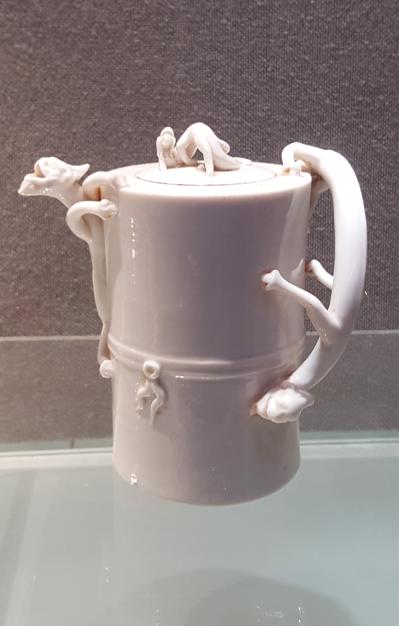

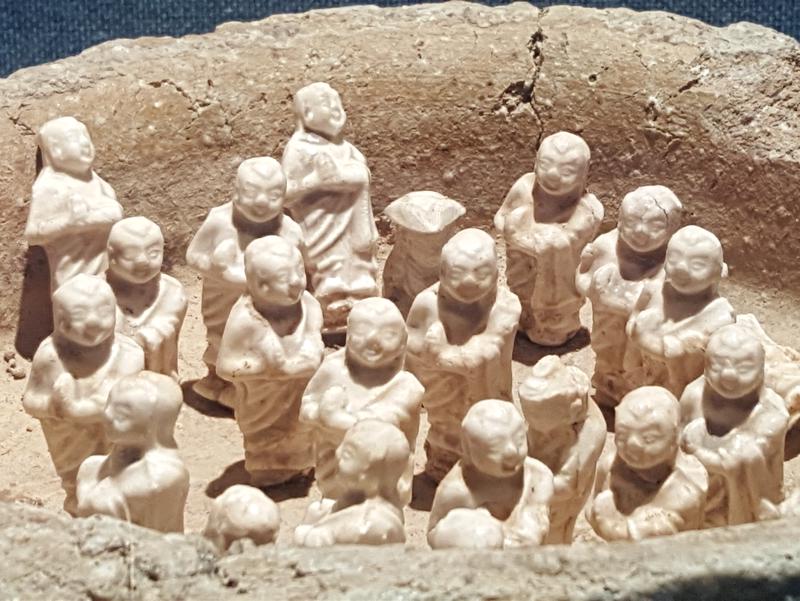

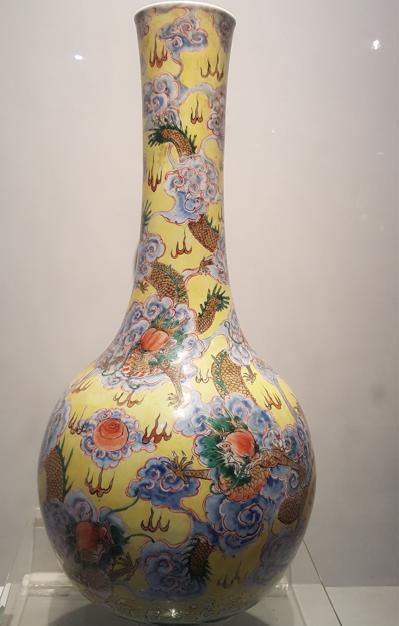
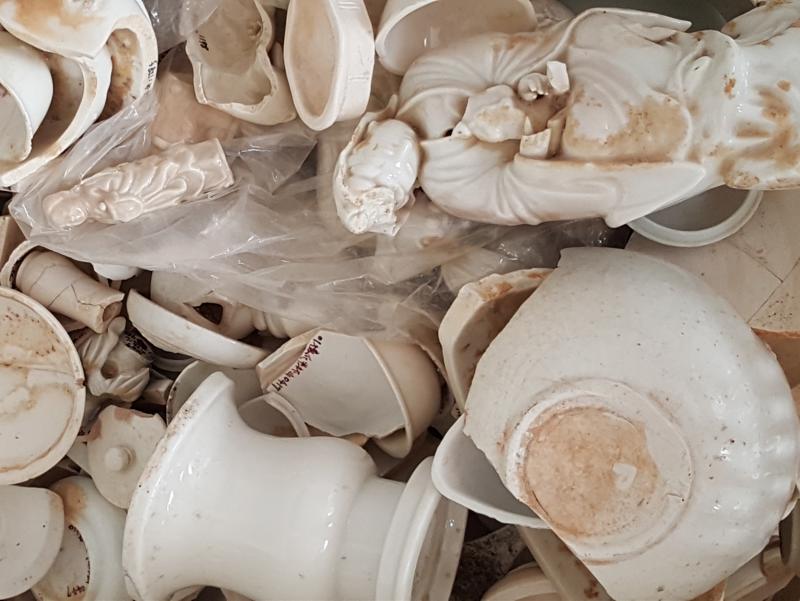
LiFang, who will be our guide for the day. For me a dream comes true. About ten years ago I saw a Ming Dynasty white ewer, chi-dragon decorated, with animal handles when visiting the Taiwan National Palace Museum with my father. Ever since, I had longed to be here and see more.
LiFang, on the left, is a master in porcelain, very strong and serious, with penetrating eyes. She appreciates the specialists in our group, I follow along and make notes of the answers to their questions. In this museum there are old Tang sherds and pots, stone grinding and dyeing bowls, pestle and sag-gars, Edmund de Waal writes about white porcelain from Jingdezhen: what about this Dehua porcelain? The distinctive blanc de chine porcelains were initiated towards the end of the Ming dynasty; their production considerably increased during the seventeenth and eighteenth centuries.
There is a pot with small Chinese figurines in it and even a figurine of
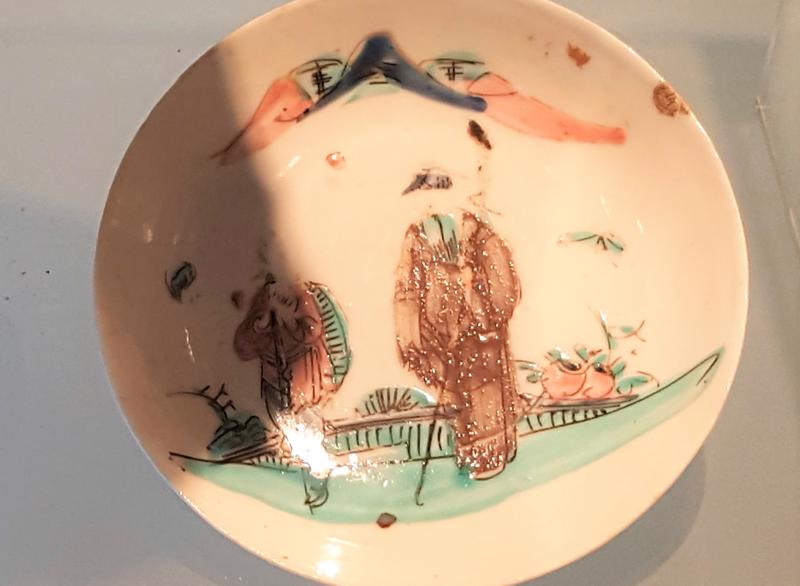

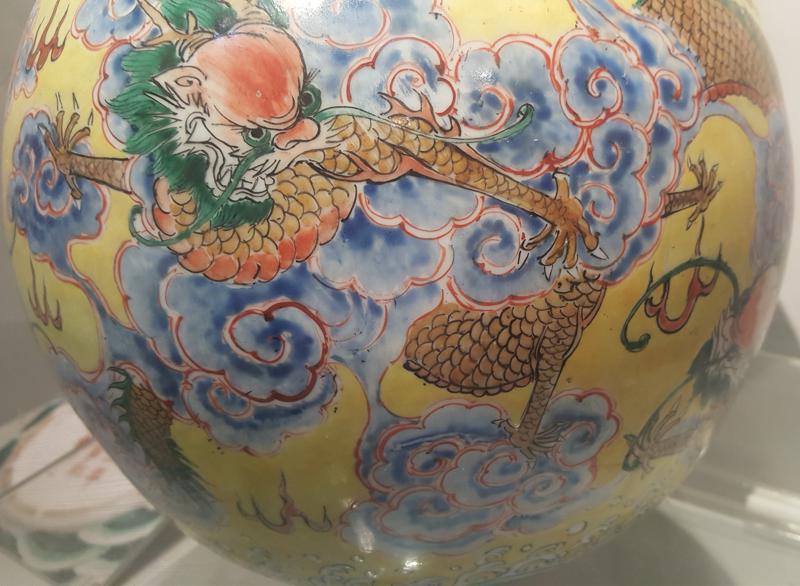

a European man with a sunbonnet on his head. It stems from which period? The description in English does not say.
In the Peabody Essex Museum catalogue on export porcelain, a full chapter is written on the comparison between Dehua and Jingdezhen unglazed ware. The figurines with bonnets in the pictures in that book are from AD 1700 – 1720.
But then, Dehua started to be exported to Europe in the 17th century already. The nationality of our “European man” is not known either - he could be a Portuguese, English or Dutch person.
In this museum, Southern and Northern Song porcelains are exhibited, together with wonderful celadons and even brilliant modern porcelains. The porcelains from the Song on show are mainly daily life utensils such as bowls, plates, dishes, lavers, vases, boxes, pots and ewers. There is an enormous diversity of shapes mingled with rich pattern motifs.
The Ming dynasty is the peak period for porcelain sculpture production in Dehua. Skilled craftsmen such as He Chaozong, Cheng Wei and Lin Chaojin drew on the experience of the art forms of clay sculptures and wood carving, vigorously pursuing the
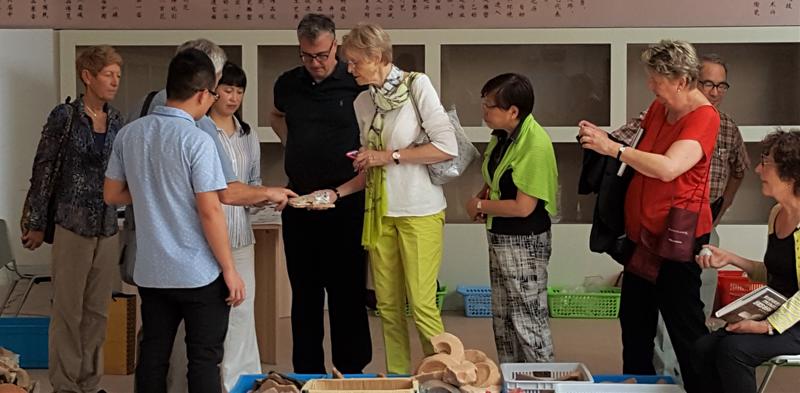

combination of material features and artistic styles. Their perfect ancient Chinese Taoist and Buddhist figures were hailed “The pearl of Oriental Art”. The Ming dynasty Guanyins are splendid, five of them are exhibited in line next to each other. Pressing our noses against the glass window, we adore them very much.
One tends to forget that blue-and-white was produced here in Dehua too, as many times only the white porcelains are shown. But here, blue and white objects are represented on a large scale. The simple styles and shapes suit their practical purpose; blue-and-whites were not used for decoration only. On the production wheel, the biscuit model was widely used, shapes were standardized to suit mass production.
I think of Christian Joerg (luckily often giving lectures to our VVAK audience). In Germany (Dresden) he researches the porcelain collection of Friedrich Augustus I (1670-1733) also named Augustus the Strong. This emperor had a collection of Dehua porcelain (see picture) as well!
One of the exhibition rooms shows Qing materials with wooden furniture, blue-and- white figurines in panels, round and covered boxes. The Qing style is different in style; we get a good overview.
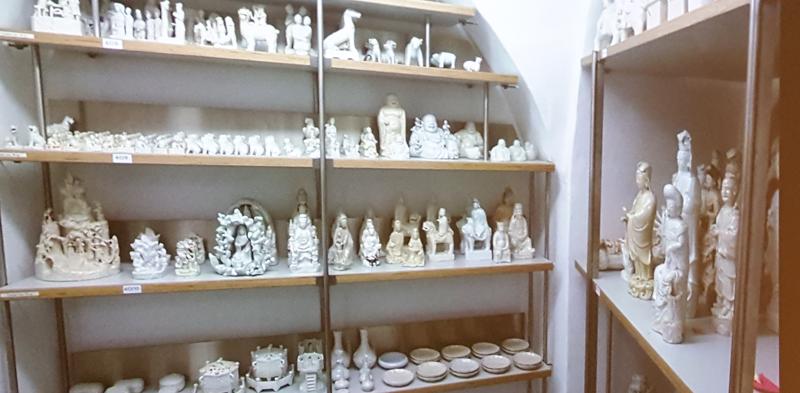
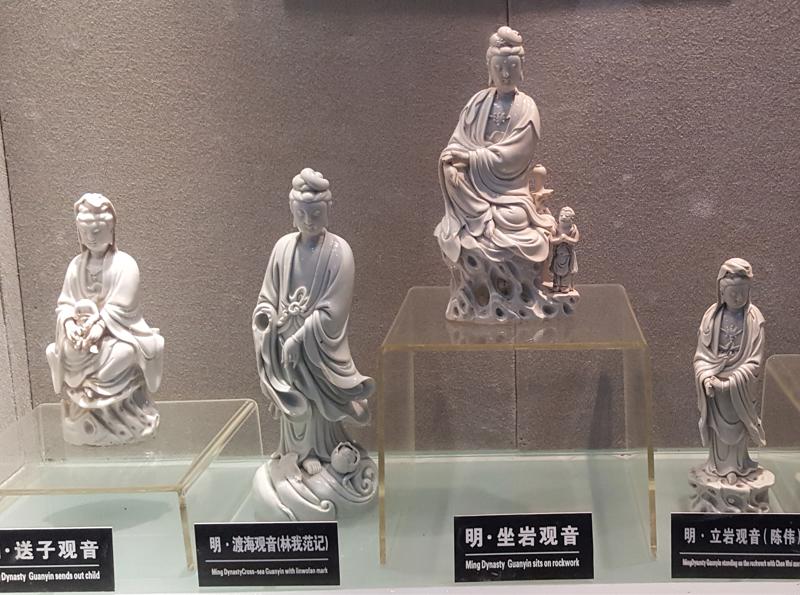

The potters‘ brushes covered a wide spectrum of themes: activities such fishing, hunting, farming; landscapes with mountains, rivers, trees and stones, flowers, fish and birds; dragons and phoenixes filled with magical romantic colors. The painting is rough and plain; the designs have a free structure full of life and breath.
We particularly admire a poly-chrome vase with a Kangxi 25 years’ reign mark; it is yellow with beige dragons and blue clouds.
The Qing dynasty white porcelain had a greenish-blue glaze. There were two major categories: the sculptures and the daily utensils. A five bats and 100 shou patterned blue-and-white plate is very special, so cool and regular its motif. Under a dragon like old tree, besides the fret patterned rails, a young scholar is sitting on the ground, behind six layers of books; on the table incense is burning. Only a few strokes were applied to outline a picture of this unsophisticated scholar’s reading and studying time. A scholar reading his book is also a special motif for blue and white porcelain. This type of work was prevalent in the Academy – it emphasized Qianlong and Jiajings ‘ reign, which reflected the economic and cultural life of that society. Even in remote mountainous areas the academic lifestyle was popular.
The major contribution of the white Dehua porcelain to the porcelain trade succeeded for many generations. In trade this white porcelain was dubbed “Blanc de Chine”. The sculptures and Blanc de Chine were closely integrated and mutually reinforced. Dehua porcelain was pushed unto the peak of world ceramic art. During the Qing the Dehua porcelain art was lost for over 300 years. Until the early 1960’s when the Fujian Light Industry Institute and Dehua Porcelain factory resumed studying and producing, which succeeded in 1965, the products were named “Jian White Porcelain”.
Back in the Southern Song dynasty, Dehua kilns like Jiachunling and Taipinggong had already fired white porcelain at high degrees. In 1958, the Dehua factory developed a superior quality high-white porcelain again, fired in high temperature reducing atmosphere; its body is fine and tough, the glaze integrated closely, lustrous and snowy-white. Measured by the National Ministry of Small Industry the degree of whiteness reached 88.8 points. These modern ceramics are shown here as well, in a separate room. We see great statues of bulls and a Guanyin with thousand arms. This space breathes artistic loveliness. There are funny brilliant compositions on show here. Black Guanjins with white topped heads, a tree with porcelain branches covered with small white figurines. We walk over to a room, which seems to function as a type of shop. We are checking books about Dehua, piled up on the floor. There is a sweet Dehua Guanjin looking up at me from a box on the floor, I adore her, consider taking her home – but am not clear on how to do that. Can I trust the parcel service in China? Instead, I buy a book showing the collection here; the text reads in Chinese only, but the numeric symbols indicate the period of production.
We are guided to the room where the researchers do their studies. Presently, sherds excavated at Dehua kiln sites are under scrutiny. The highly translucent low-oxide porcelain is of beautiful quality, even in their broken status. The porcelain was fired at temperature higher than 1268 Celsius; Dehua porcelain stone has little iron in it. The
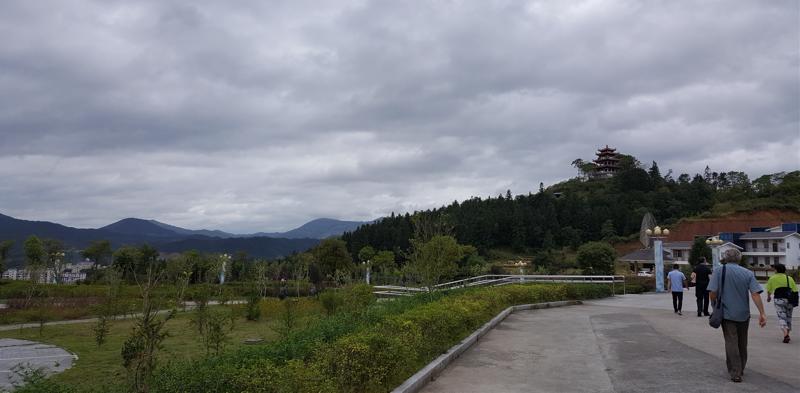
glazes have an unctuous brilliance due to the high alkali content in the Dehua porcelain stone. The sherds are divided over crates with labels indicating type and/ or period on them. I find a box with a Guanjin with a bent head; it came out of the kiln like this, and looks very poetic in this box full of sherds. Who will be putting the pieces back together? One day I will better understand the glazes, for the moment at least, I recognize the blueish green glazed sherds from the Qing. Very interesting to see how the layers of glaze and porcelain interface with each other, this is why sherds are so great for study purposes. Unfortunately, there is no WiFi here and no QR code anywhere. Visitors could learn much more if those options available.
Leaving the museum we gaze into the wonderful real-life the Chinese landscape of mountains, a palm tree and clouds and ask ourselves what will be awaiting us.
At lunch time, we stop at an old Wild West looking Saloon, a white house, with a terrace in front and a door in the middle. We are guided to a private room on the first floor with a big round table. We are in great company of Chen LiFang, Sou and the driver. It is hot

here, but the green leaves are so tasty and eating with chop sticks is going much better now, although Bente states she will help me find a spoon. On her watch it is then 12:54 – and I shoot some lovely pictures as the group is buzzing with joy at the big round table.
In the afternoon we are taken by bus into the mountains and hills of Dehua, to visit an old Dehua dragon kiln. The bus drops us off on the side of the road, and before we know it Bente gets seated in a huge fancy car. Looking chique as she always does, I take it now that our Bente is being kidnapped! As I start screaming for her to jump out of the car, a big man arrives in a bright yellow blue striped shirt. He looks very kind for a kidnapper; indeed he happens to be the major of the village, who will take us to the site where the kiln is. The major seems to forgive me; with the big car he drives us up to the site where the archaeologists are digging up shards and parts of kilns here. It is a very long dragon kiln, located next to the type of tiny village one finds painted on porcelain: small houses perched against the hill; very green and beautiful it is here. A tiny temple overlooks
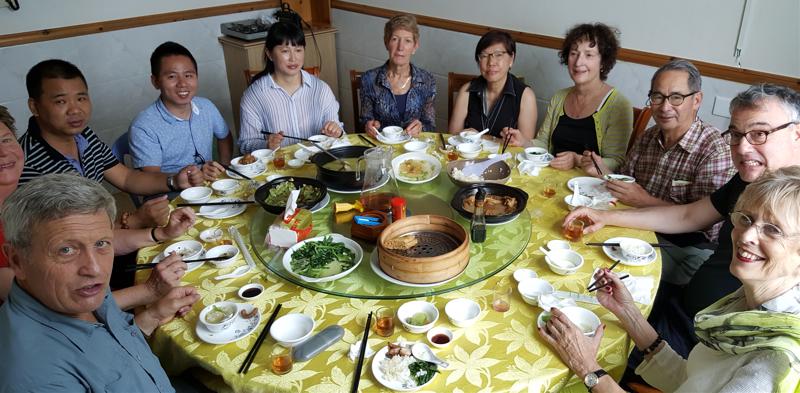
the valley. The sun blasts down on nature including us. The earth is reddish yellow ochre here; if I understand Nigel Wood well, there will be less than 0.2% oxide in it. Since 1954, Chinese archaeologists have discovered more than 300 kiln sites dating from the Song, Yuan, Ming and Qing dynasties in the Fujian province. By 1990, 148 kiln sites have been established and documented as belonging to the Dehua district alone. Even if Dehua Blanc-de-Chine is the most well-known, it was by no means the only ware produced in Dehua, let alone in Fujian. The archaeologist shows us a map of the kiln we are visiting, showing where it is located in Dehua. These persons are so skilled and well planned and take notes and measurements in the heat of the afternoon. Shards, saggars and building blocks are all over the place. We look at the sherds and learn that there is really modern porcelain here. LiFang assists us all the time to understand what we are seeing; she wears the gear to protect herself against sun tanning.
It is exciting to be so close to the source here, the place where beautiful porcelain got produced. On our way back Wai Lan and the group save me from running into a snake. Sam - from up the mountain - calls out to me: “YOUOUOU! DUMMMYYYYYYYY!!!”
On the mountain in front of us, at the foothill the small temple is there,
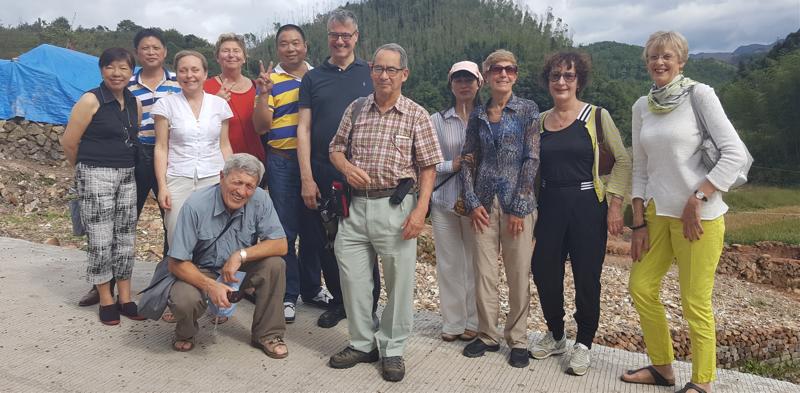
or is it a place for sacrifices, it looks lovely but too far away, and a snake may come up again. The major is very kind and shows us around, Carl and Truke take a close look at the sherds, Wai Lan is asking questions in Chinese. It may be that we are visiting the site Yi in Mei Ling and that Zhuweicho ([email protected]) is the archaeologist, I take a picture, validation of text remains an issue for me as a non-Chinese reader.
The bus in the afternoon brings us to the parking near a school square where children are playing. Lots of very cute children come running to us; they run up and down and around us, we start giving high fives and shaking hands. It becomes difficult to follow LiFang and Sou. But the dragon kiln patiently waits for us to calm down and take a close look. This is the Qudougong porcelain kiln, which is located on the Southwest slope of Pozhai hill, Baomai village at the southeast side of of Dehua county, marvelous!
Footnote:
This kiln is a key national cultural relic. It is called Qudougong after a small temple that was in the neighborhood. Xiamen university excavated it in 1976, it is was used during the Song and Yuan. It is 300 meters wide and about 150 long. The kiln base excavated is 57.1 meters long. There were 17 kiln chambers with over 800 pieces of furniture and 6,790 complete and incomplete utensils unearthed. The kiln head firing furnace and the kiln bed of this kiln are well-preserved. It has a wide kiln body, with a narrow firing furnace with a semicircular shape. Outside of the junction between the firing furnace and the kiln bed there are five firing holes. The kiln chamber is generally rectangular and there are firing route ditches on both sides, and there are partition walls (firing barriers) among the chambers. At the bottom of the walls were designed firing holes and the inclined bottom of the kiln chamber is paved with fine quartz sand on the top, and saggar pad or brackets are placed on it. According to
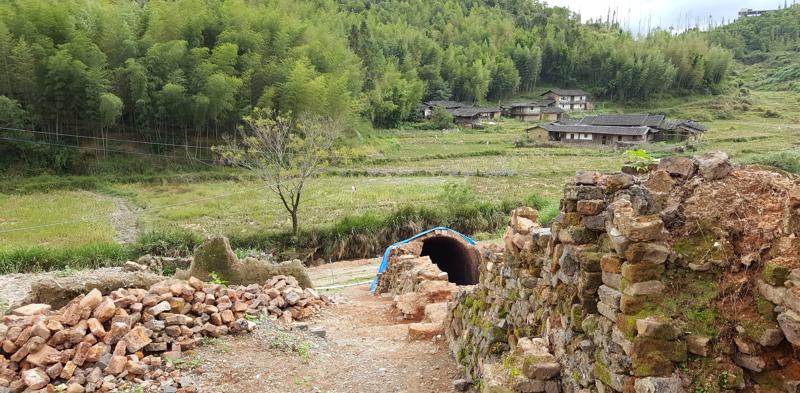
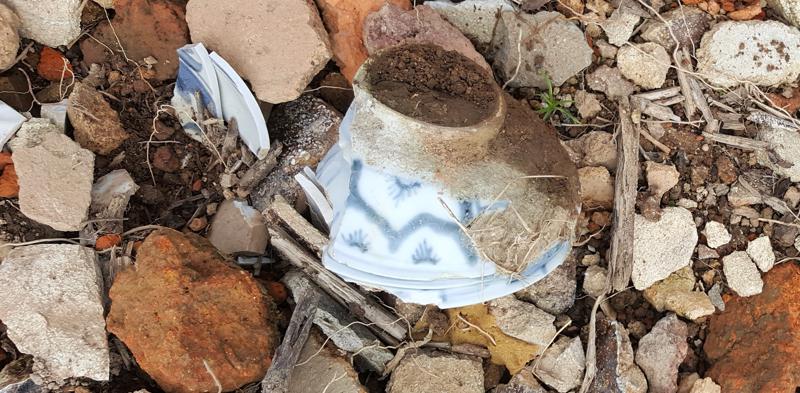
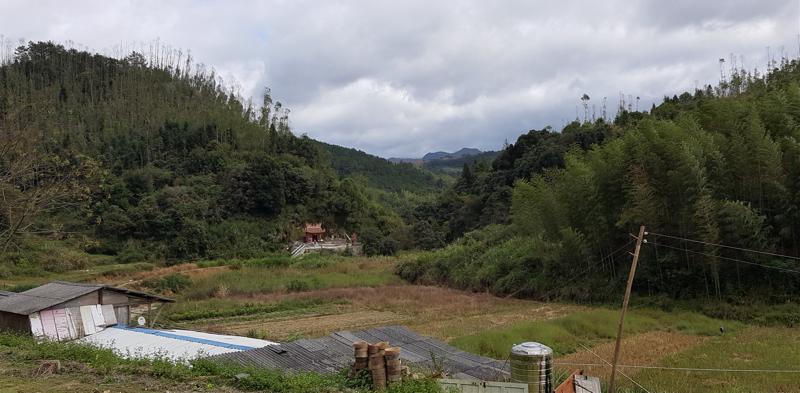
the current analysis of the kiln, this is a unique kiln: a so-called “cage kiln” designed from the dragon and the ascending kiln. That it is a cage kiln is clear from the structure of the excavated kiln base.
The production tools unearthed at this kiln include moulding, performing turn plate, iron knives for knocking the sag-gar, sag-gar pads, and other sag-gars. There are more than 10 kinds of utensils including bowls, plates, dishes, pots, cans, bottles, writing brush washers, cups, boxes, stem-cups and more. The glazes include the white glaze close to the misty blue series and grey glaze and yellow glaze formed by incomplete firing. The decoration methods include printing, scratching, descaling, embossing. On some box covers there are printed auspicious characters such as “longevity”, “gold and jade”, “longevity and blessing”, “new boat of longevity”. The porcelain shaping and firing methods bear obvious characteristics of those in Song and Yuan dynasties. It has significant value in the research of the Song and Yuan eras and the system of folk kilns, ceramic industry and production scale, kiln structure, firing techniques, porcelain export in China.
From here our driver takes us to the Dehua temple: here, sacrifices were made to the porcelain god to get a blessing for location of each
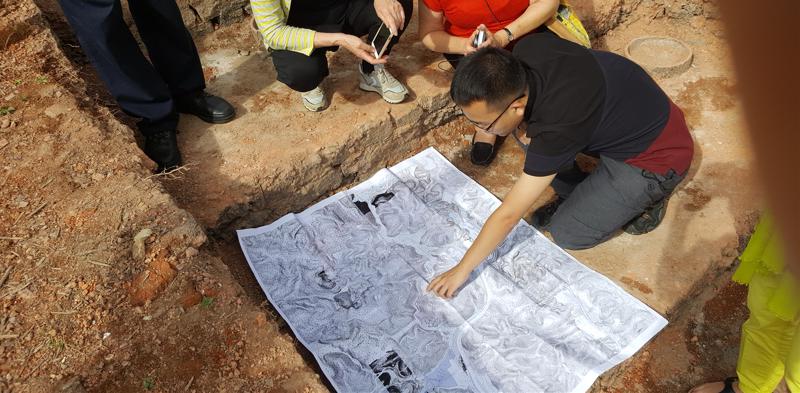

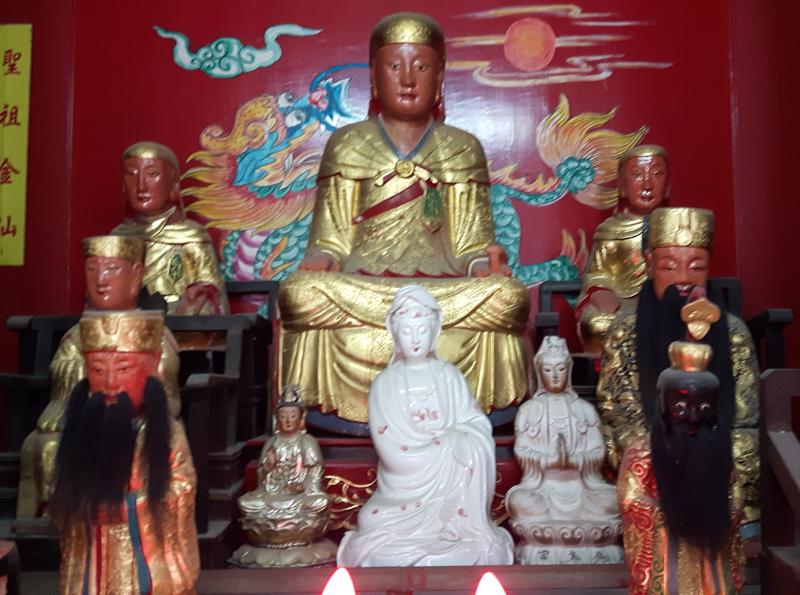
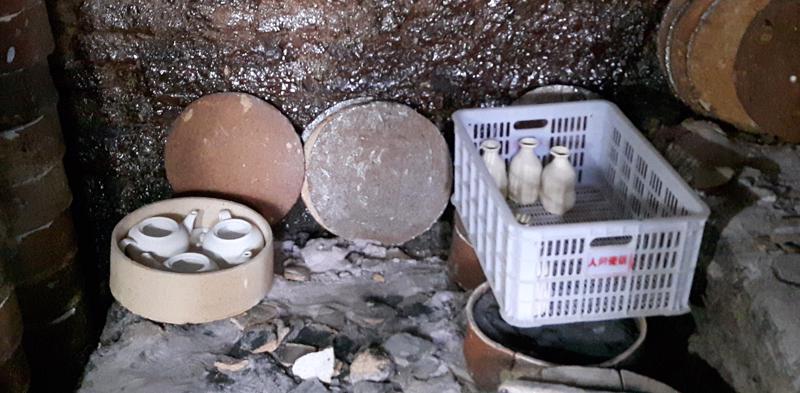
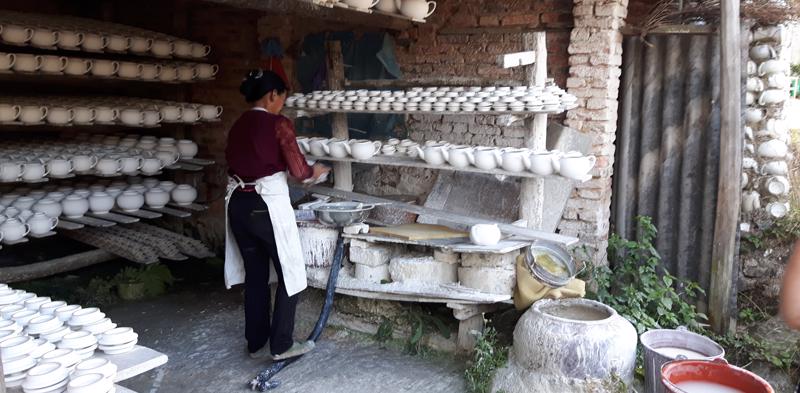
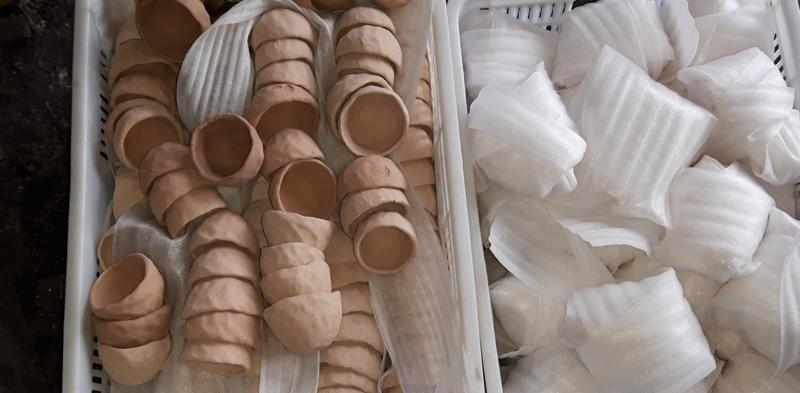
kiln and its location.
It is still very hot. The roof of the temple is exuberant. A couple sits at the entrance; they look like the guards of this place. They pour tea and we put money in a pot to keep the god in a proper mood. Carl teaches me to throw the sticks to learn more about my fate in life. After shaking the sticks, I throw one out with the dragon sign, the best sign. The guard nods at me in accordance with my luck. Wai Lan translates for me: I need to be patient, but luck will come my way!
Behind the temple we take a walk; there are some shards there and a black chicken that attracts my attention. Unaware of the wonderful shards it carelessly hops around. In the meantime, the group has moved on; I cannot find them, so I linger and watch the banana palm tree and the open houses, where there is a flurry of scooters, scraps and family gatherings. Seems we are on another dragon kiln hill from the Song. The group appears all of a sudden, walking down from the
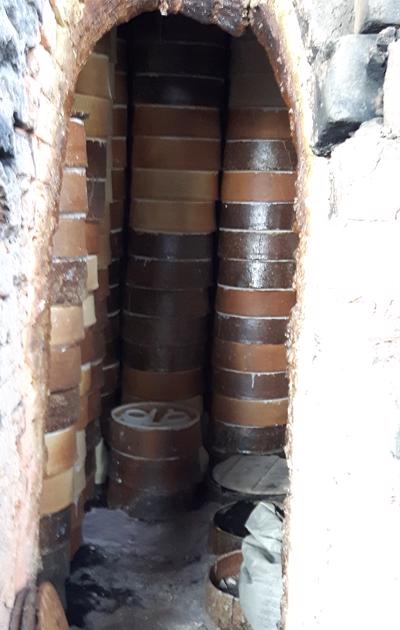

hill, so focused they are on the information from LiFang - do they note I am relieved to have found them again? The good driver lets himself be heard, as we need to leave in time for another kiln.
We arrive at the Dongshan ancient scenic spot in the Caijing village of Sanban, located at 2 km from Dehua town. This place shows the intangible nature of the firing technique and the traditional skills for ceramics made by hand. The site has six parts, it is surrounded by mountains, shaded by pines and bamboo trees.
The old dragon kiln is filled with wood and students work at this site for research.There are workshops here for handmade porcelain; this modern ware is sold here as well. After having taken a selfie for the driver with me, we go up the dragon kiln, and get to see how the glazing and firing is done. A great many teapots are going to be fired today, they are used for tea serving in hotels in the environment.
In the hazy, late, afternoon we note a lady who dips the teapots in glaze and moves the pots onto shelves – ready to get fired.
Climbing up alongside the dragon kiln, it is very steep, and we continue learning. The teapots are – three at a time – put in sag-gars and the saggars are piled up in the small kiln room.
Around us, the view from the hill is breathtaking, many trees grow on the slopes of this valley. There may be somewhat less smog at this altitude. On the trees big bracket fungi are living, brightly colored orange to vermilion.

In the Qiyang Ceramic Studio a lot of us buy something…there is a tiny earth color teapot which I fall in love with, I buy three small cups and feel so happy. These teapots absorb the tea taste over the years, they are porous and “Zen”, good for meditation. The handle of the pot stands out madly; the potter puts the pot on the turning table to straighten the bottom. Truke buys white cups; Carl buys a big tea pot; actually, everyone buys something beautiful. My small tea pot is so small and round in the cusp of my hand. The cups are very teaism like. On our way back to Dehua LiFang gets us into a private room in a restaurant in the center, with again great food. After dinner the bus takes us to a square in the center; it is a round square with green gardens in a big hole far below street level, a lovely surprise. After a great dinner we say goodbye to LiFang, it is emotional and she did a very good job guiding us, we are so lucky with her and Sou.
After dinner, Sou assists us with shopping, we lose some of the group and so Sou, Truke and I end up somewhere in the center where square dancing is performed. Chinese ladies dance in the evening to Chinese music. The background of the grey high-rise buildings seems to have no impact to the ladies dancing flawlessly to the
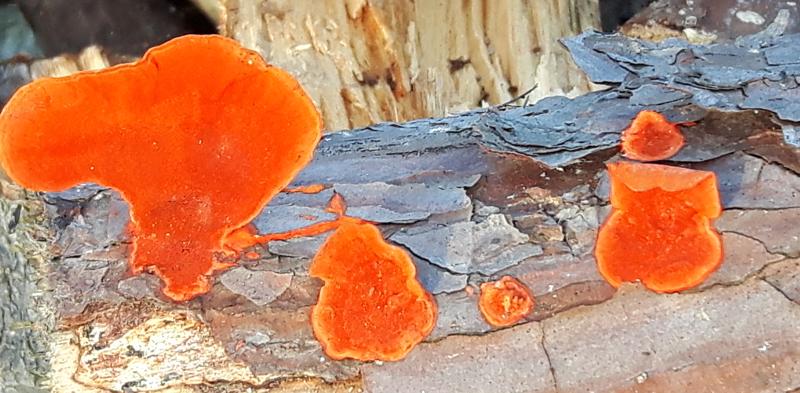
swirling music; the roaring cars in the background are not an issue either. We love the scene and take pictures.
Sou drops us off in a coffee bar, Truke and I drink coffee and chat. People ask if they may take a picture. Back at the hotel I pack my bags and take a shower as I am covered in black.
My new small teapot serves the best tea. Some windows commands I type into the XP computer, no luck, just some advertisements show up on the screen. I phone Pieter . He is doing so so, so...he pretends all goes well. I read and sing and move about the room, a weird and too luxurious life this is (so do not trust it!)…Tomorrow, we will be on the road again.
1.
Introduction
2.
Saturday October 15, 2016
3.
Sunday October 16, 2016
4.
Monday October 17, 2016
5.
Tuesday October 18, 2016
6.
Wednesday October 19, 2016
7.
Thursday October 20, 2016
8.
Friday October 21, 2016
9.
Saturday October 22, 2016
10.
Sunday October 23, 2016
11.
Monday October 24, 2016
12.
Tuesday October 25, 2016
13.
Wednesday October 26, 2016
14.
Thursday October 27, 2016
15.
Friday October 28, 2016
16.
Saturday October 29, 2016
17.
Sunday October 30, 2016
Share your travel adventures like this!
Create your own travel blog in one step
Share with friends and family to follow your journey
Easy set up, no technical knowledge needed and unlimited storage!
© 2025 Travel Diaries. All rights reserved.